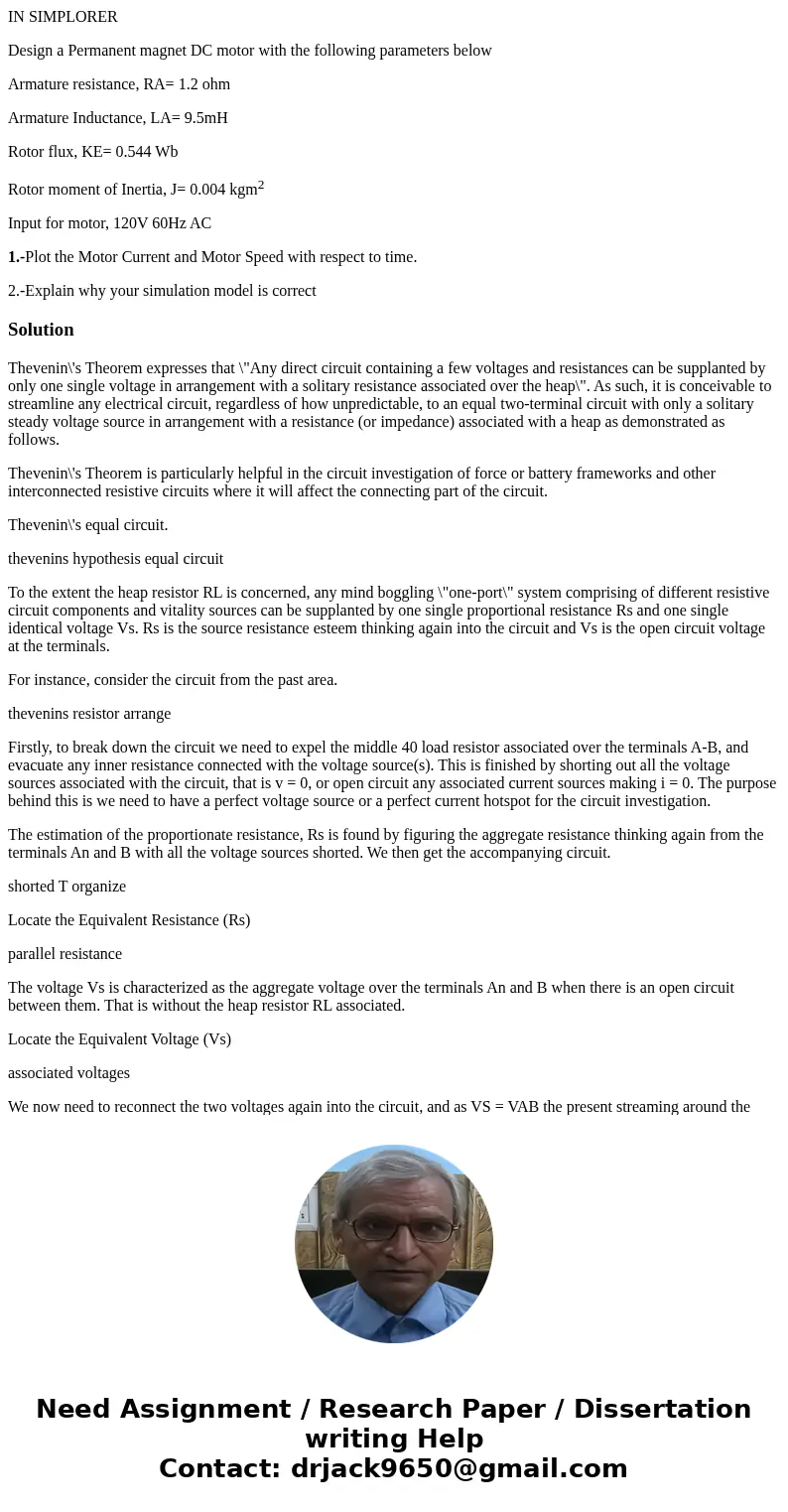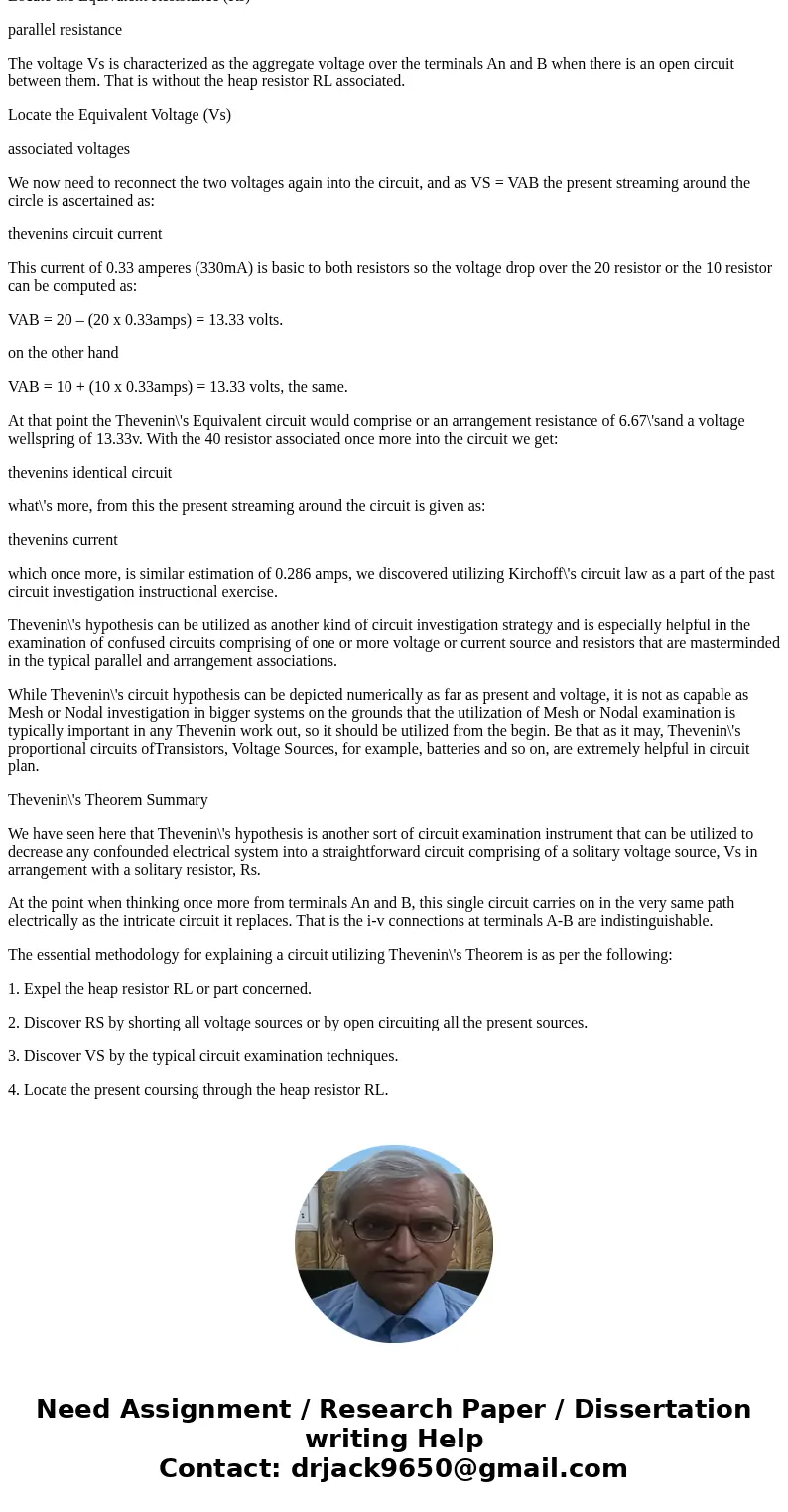IN SIMPLORER Design a Permanent magnet DC motor with the fol
IN SIMPLORER
Design a Permanent magnet DC motor with the following parameters below
Armature resistance, RA= 1.2 ohm
Armature Inductance, LA= 9.5mH
Rotor flux, KE= 0.544 Wb
Rotor moment of Inertia, J= 0.004 kgm2
Input for motor, 120V 60Hz AC
1.-Plot the Motor Current and Motor Speed with respect to time.
2.-Explain why your simulation model is correct
Solution
Thevenin\'s Theorem expresses that \"Any direct circuit containing a few voltages and resistances can be supplanted by only one single voltage in arrangement with a solitary resistance associated over the heap\". As such, it is conceivable to streamline any electrical circuit, regardless of how unpredictable, to an equal two-terminal circuit with only a solitary steady voltage source in arrangement with a resistance (or impedance) associated with a heap as demonstrated as follows.
Thevenin\'s Theorem is particularly helpful in the circuit investigation of force or battery frameworks and other interconnected resistive circuits where it will affect the connecting part of the circuit.
Thevenin\'s equal circuit.
thevenins hypothesis equal circuit
To the extent the heap resistor RL is concerned, any mind boggling \"one-port\" system comprising of different resistive circuit components and vitality sources can be supplanted by one single proportional resistance Rs and one single identical voltage Vs. Rs is the source resistance esteem thinking again into the circuit and Vs is the open circuit voltage at the terminals.
For instance, consider the circuit from the past area.
thevenins resistor arrange
Firstly, to break down the circuit we need to expel the middle 40 load resistor associated over the terminals A-B, and evacuate any inner resistance connected with the voltage source(s). This is finished by shorting out all the voltage sources associated with the circuit, that is v = 0, or open circuit any associated current sources making i = 0. The purpose behind this is we need to have a perfect voltage source or a perfect current hotspot for the circuit investigation.
The estimation of the proportionate resistance, Rs is found by figuring the aggregate resistance thinking again from the terminals An and B with all the voltage sources shorted. We then get the accompanying circuit.
shorted T organize
Locate the Equivalent Resistance (Rs)
parallel resistance
The voltage Vs is characterized as the aggregate voltage over the terminals An and B when there is an open circuit between them. That is without the heap resistor RL associated.
Locate the Equivalent Voltage (Vs)
associated voltages
We now need to reconnect the two voltages again into the circuit, and as VS = VAB the present streaming around the circle is ascertained as:
thevenins circuit current
This current of 0.33 amperes (330mA) is basic to both resistors so the voltage drop over the 20 resistor or the 10 resistor can be computed as:
VAB = 20 – (20 x 0.33amps) = 13.33 volts.
on the other hand
VAB = 10 + (10 x 0.33amps) = 13.33 volts, the same.
At that point the Thevenin\'s Equivalent circuit would comprise or an arrangement resistance of 6.67\'sand a voltage wellspring of 13.33v. With the 40 resistor associated once more into the circuit we get:
thevenins identical circuit
what\'s more, from this the present streaming around the circuit is given as:
thevenins current
which once more, is similar estimation of 0.286 amps, we discovered utilizing Kirchoff\'s circuit law as a part of the past circuit investigation instructional exercise.
Thevenin\'s hypothesis can be utilized as another kind of circuit investigation strategy and is especially helpful in the examination of confused circuits comprising of one or more voltage or current source and resistors that are masterminded in the typical parallel and arrangement associations.
While Thevenin\'s circuit hypothesis can be depicted numerically as far as present and voltage, it is not as capable as Mesh or Nodal investigation in bigger systems on the grounds that the utilization of Mesh or Nodal examination is typically important in any Thevenin work out, so it should be utilized from the begin. Be that as it may, Thevenin\'s proportional circuits ofTransistors, Voltage Sources, for example, batteries and so on, are extremely helpful in circuit plan.
Thevenin\'s Theorem Summary
We have seen here that Thevenin\'s hypothesis is another sort of circuit examination instrument that can be utilized to decrease any confounded electrical system into a straightforward circuit comprising of a solitary voltage source, Vs in arrangement with a solitary resistor, Rs.
At the point when thinking once more from terminals An and B, this single circuit carries on in the very same path electrically as the intricate circuit it replaces. That is the i-v connections at terminals A-B are indistinguishable.
The essential methodology for explaining a circuit utilizing Thevenin\'s Theorem is as per the following:
1. Expel the heap resistor RL or part concerned.
2. Discover RS by shorting all voltage sources or by open circuiting all the present sources.
3. Discover VS by the typical circuit examination techniques.
4. Locate the present coursing through the heap resistor RL.


 Homework Sourse
Homework Sourse